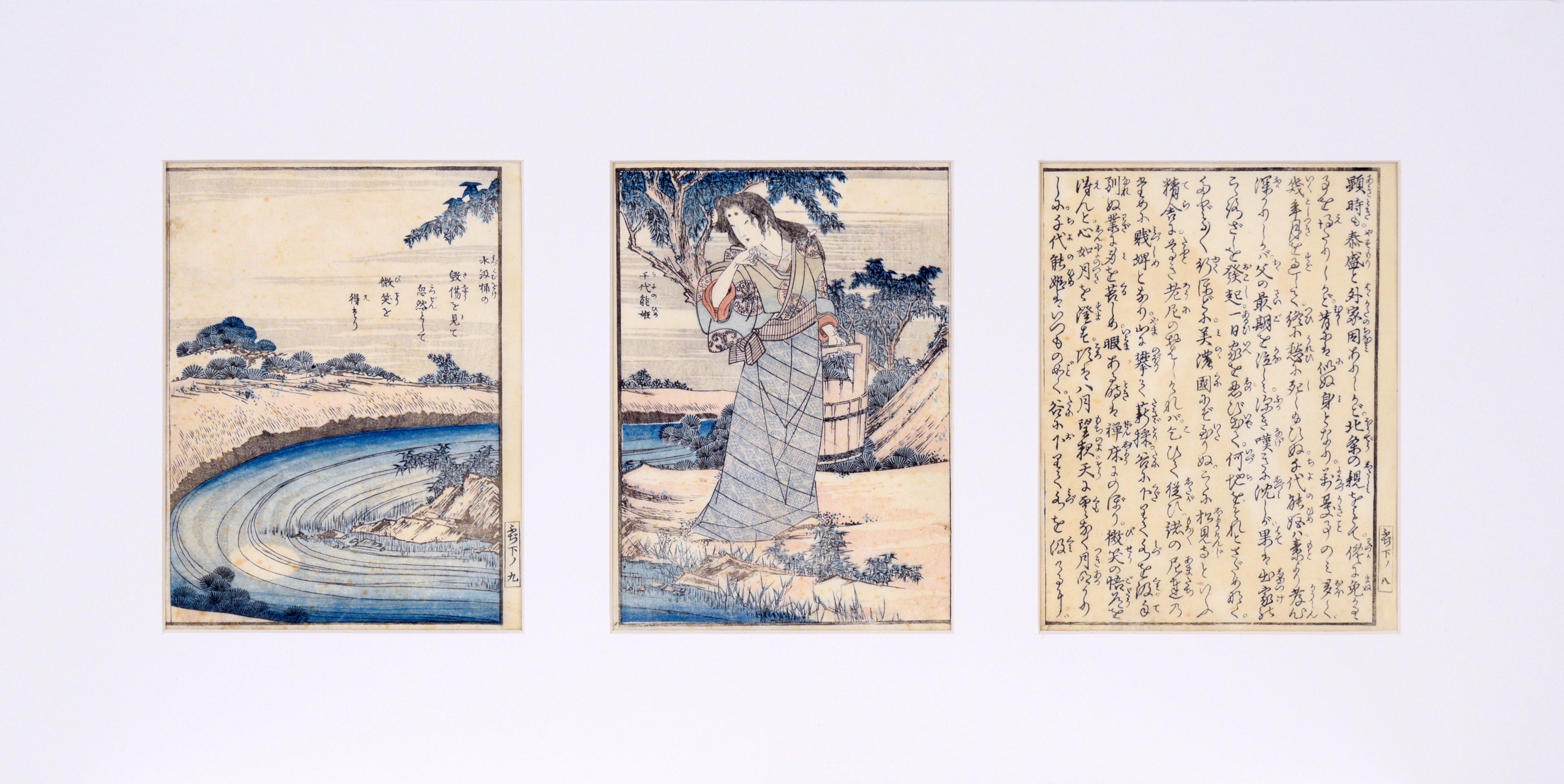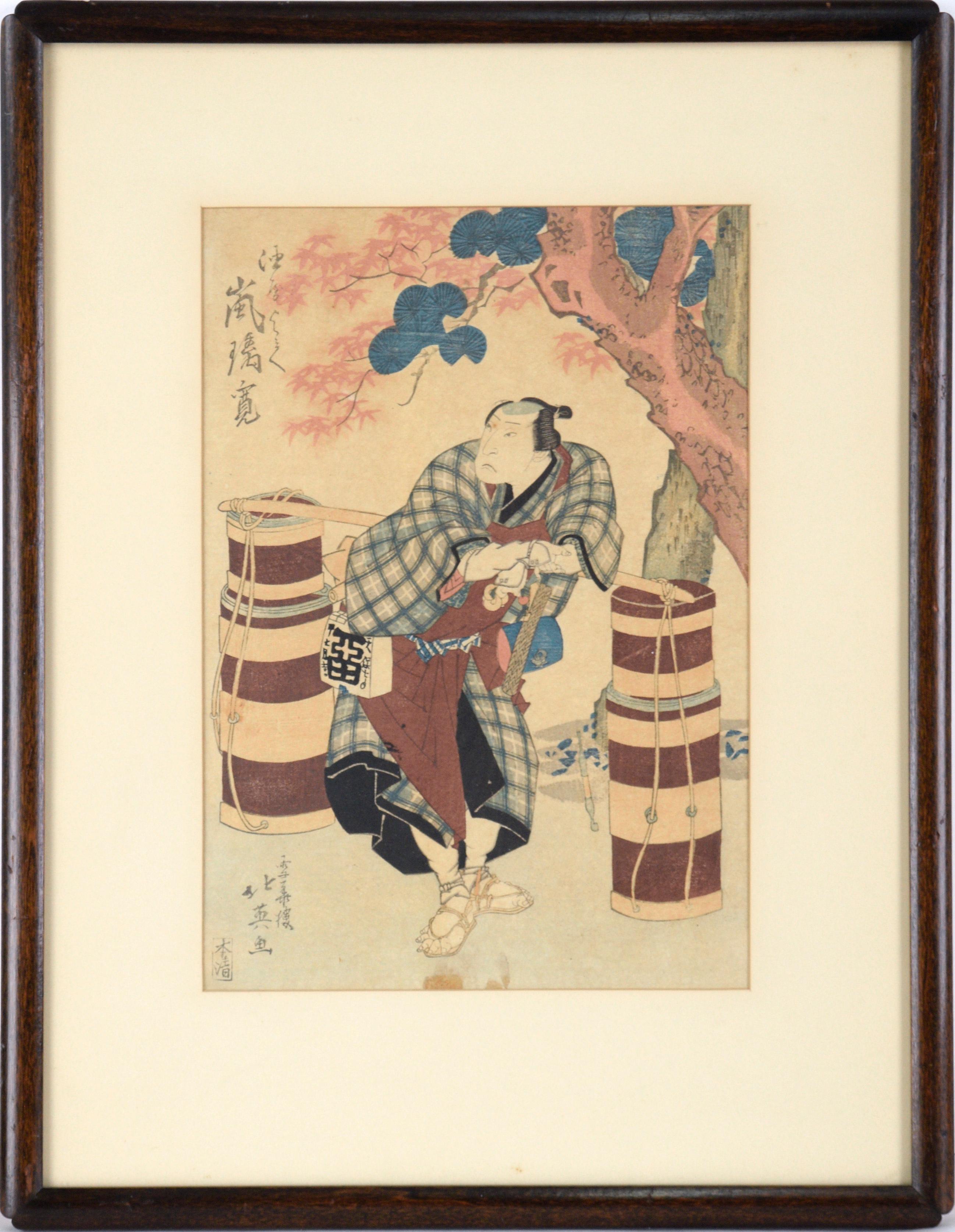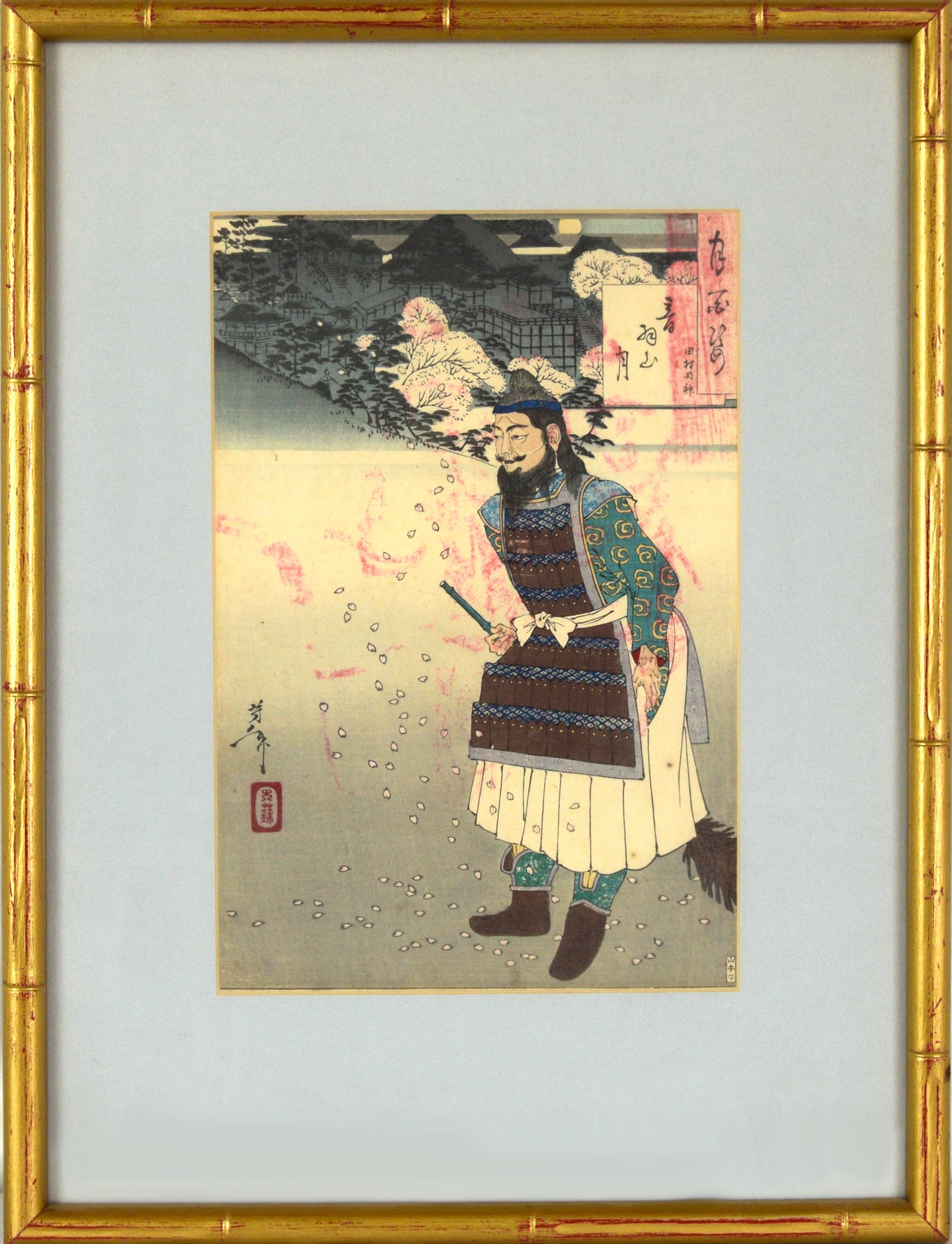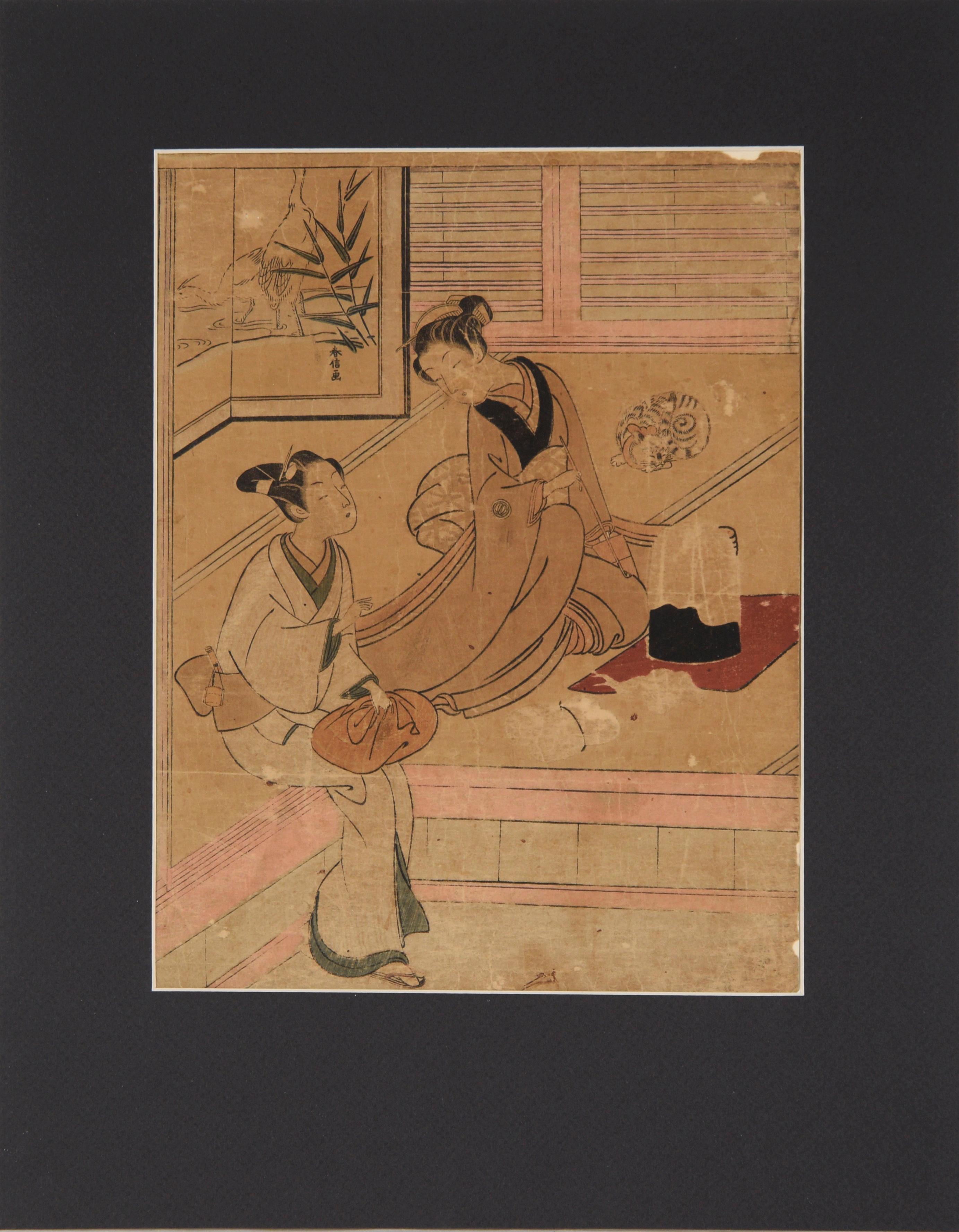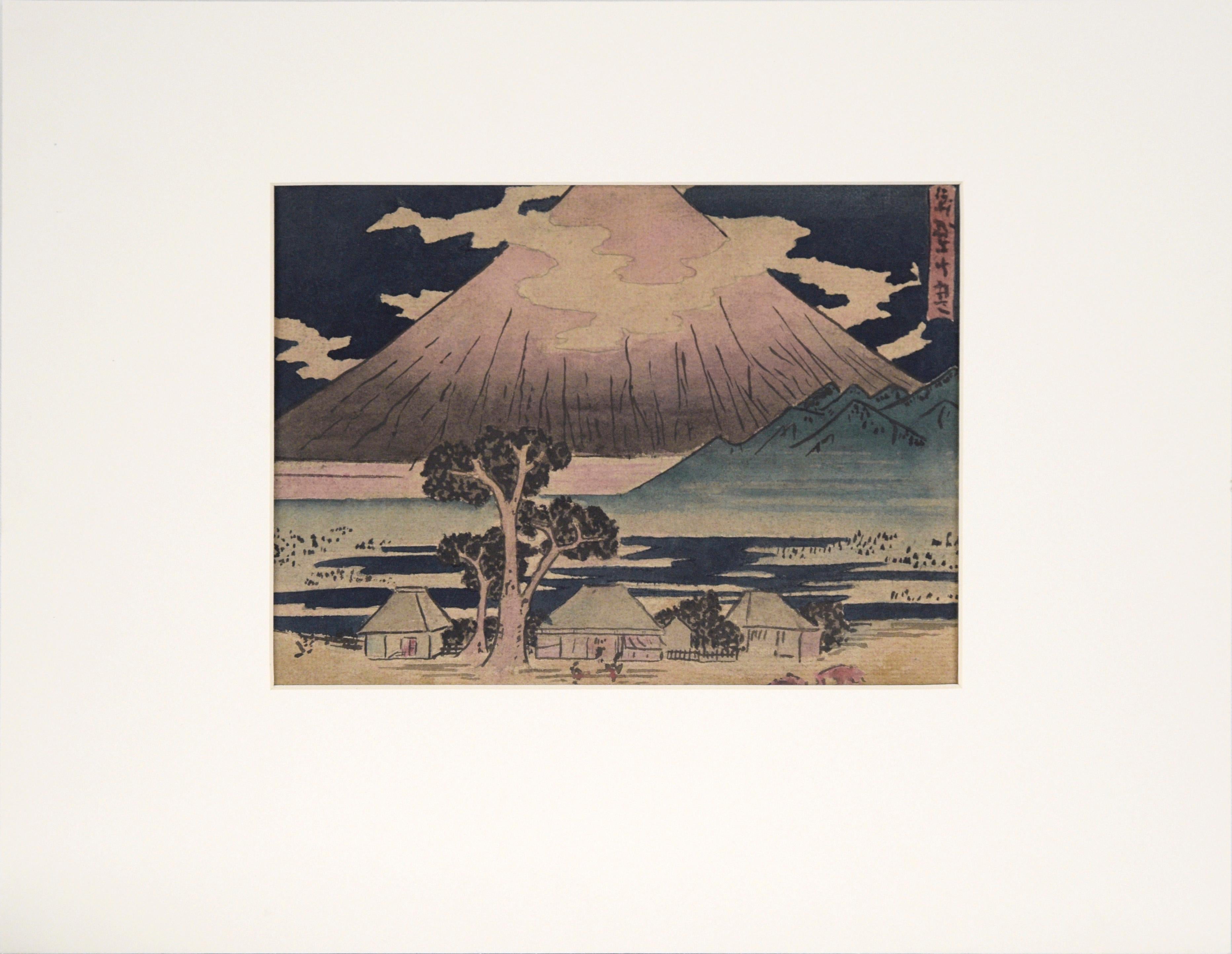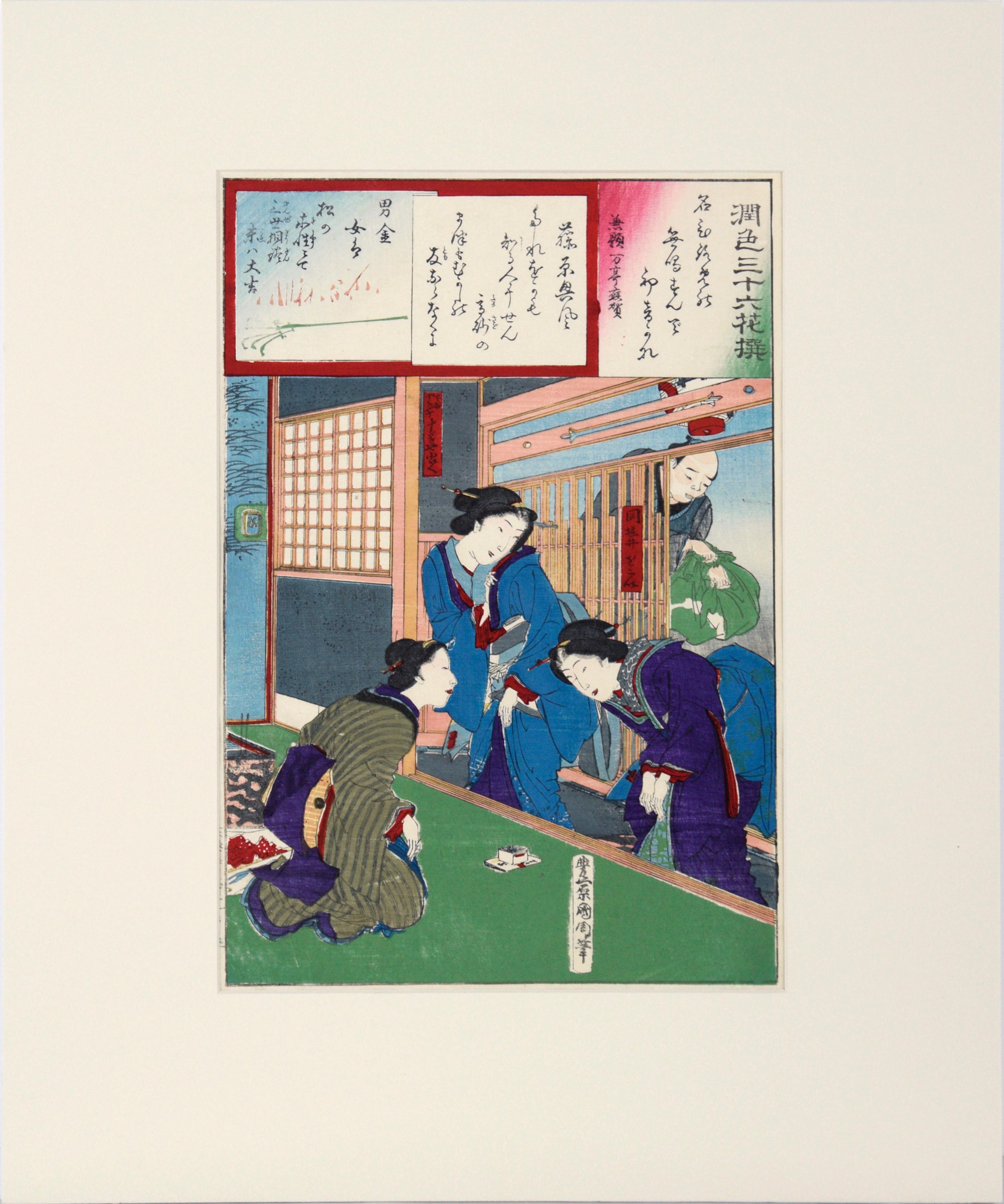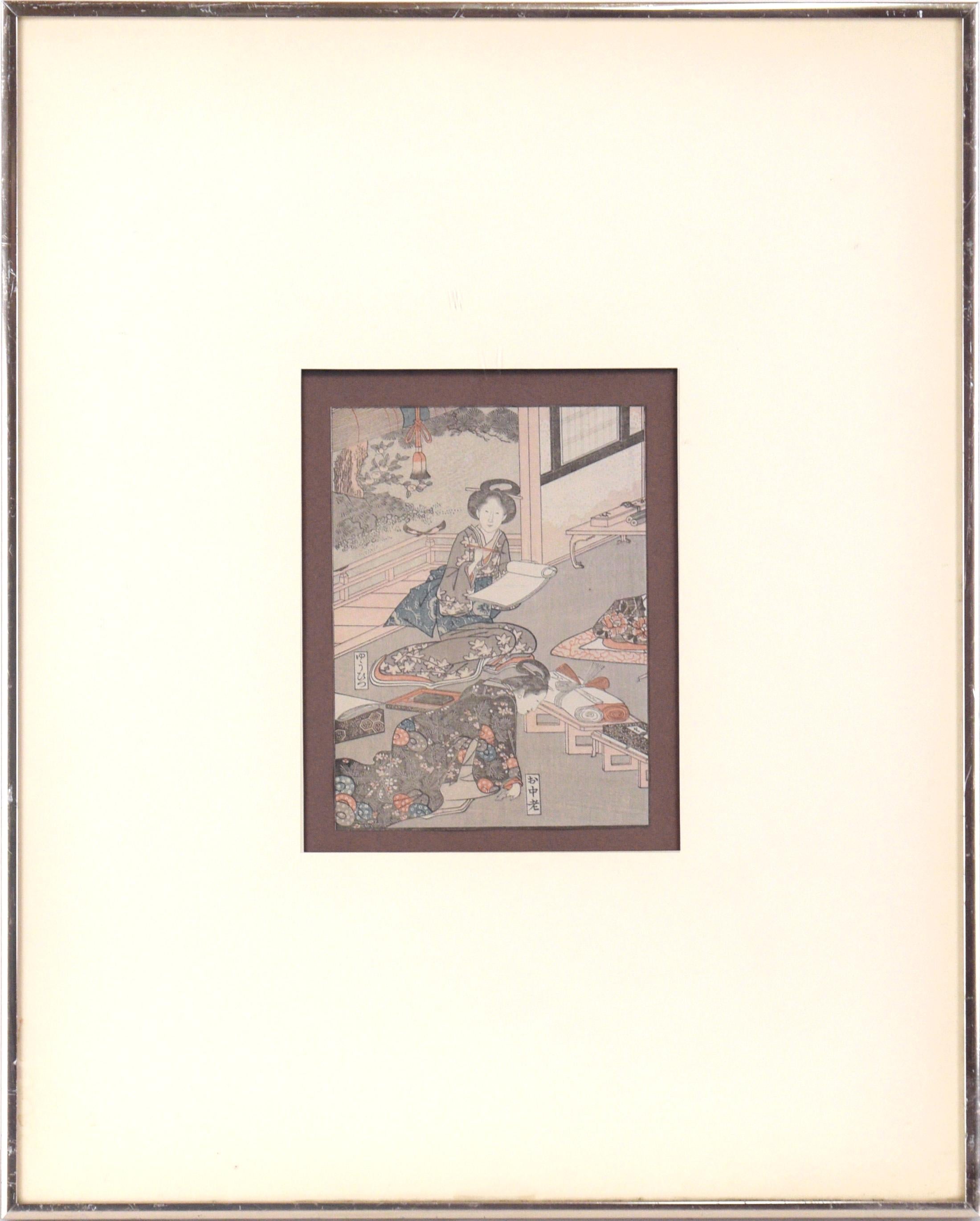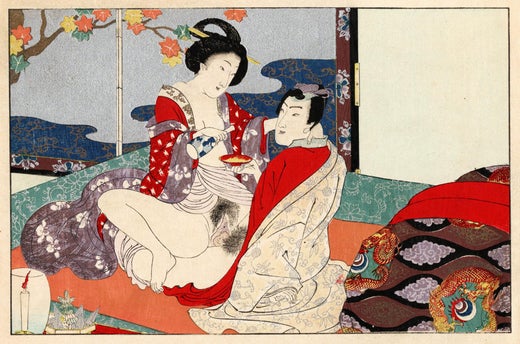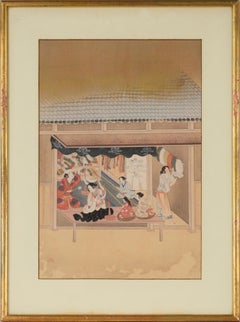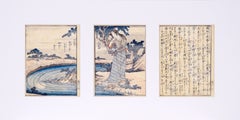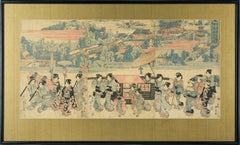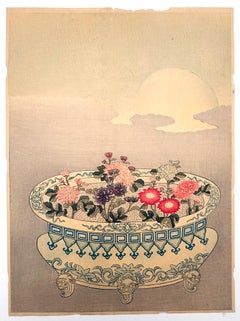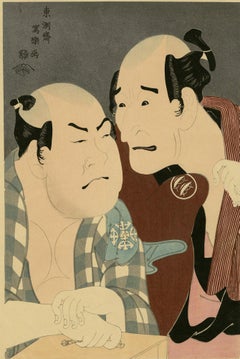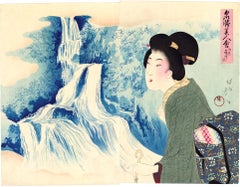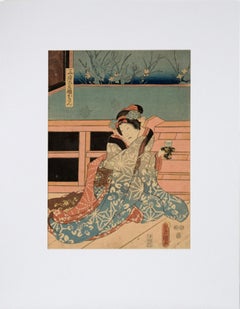
Woman Drinking Tea - Mid 19th Century Figurative Japanese Woodblock Print
Want more images or videos?
Request additional images or videos from the seller
1 of 15
Utagawa Kunisada (Toyokuni III)Woman Drinking Tea - Mid 19th Century Figurative Japanese Woodblock Print1850's
1850's
Price:$400
$575List Price
About the Item
- Creator:Utagawa Kunisada (Toyokuni III) (1786-1864, Japanese)
- Creation Year:1850's
- Dimensions:Height: 21 in (53.34 cm)Width: 16 in (40.64 cm)Depth: 0.25 in (6.35 mm)
- Medium:
- Movement & Style:
- Period:
- Condition:Some minor age toning may be present to paper. Paper sheet may have been trimmed slightly. Two drip marks on paper (see photos). Artwork was mounted to backing paper at top corners by a previous owner.
- Gallery Location:Soquel, CA
- Reference Number:Seller: DBH83421stDibs: LU54211539772
Utagawa Kunisada (Toyokuni III)
Born in the Honjo district of Edo as Kunisada Tsunoda, Kunisada’s family owned a small hereditary ferryboat service. Though his father, an amateur poet, died when Kunisada was a child, the family business provided some financial security. During his childhood, he showed considerable promise in painting and drawing. Due to strong familial ties with literary and theatrical circles, he spent time studying actor portraits. At age 14, he was admitted to study under Toyokuni, head of the Utagawa school. Kunisada's work embodies the characteristics of the Utagawa school, focusing on traditional subjects such as kabuki, bijin (beautiful women), shunga (erotic prints), and historical prints. His first known print dates to 1807, his first illustrated book to 1808. Kunisada’s career took off from the beginning. Many of his works became overnight successes and he was considered the “star attraction†of the Utagawa school. He signed his works “Kunisada,†sometimes with the studio names of Gototei and Kochoro affixed. In 1844, he adopted the name of his teacher and became Toyokuni III. Kunisada passed away in 1864 in the same neighborhood that he was born. He was 70 years old. Kunis
About the Seller
5.0
Platinum Seller
Premium sellers with a 4.7+ rating and 24-hour response times
Established in 1986
1stDibs seller since 2014
2,948 sales on 1stDibs
Authenticity Guarantee
In the unlikely event there’s an issue with an item’s authenticity, contact us within 1 year for a full refund. DetailsMoney-Back Guarantee
If your item is not as described, is damaged in transit, or does not arrive, contact us within 7 days for a full refund. Details24-Hour Cancellation
You have a 24-hour grace period in which to reconsider your purchase, with no questions asked.Vetted Professional Sellers
Our world-class sellers must adhere to strict standards for service and quality, maintaining the integrity of our listings.Price-Match Guarantee
If you find that a seller listed the same item for a lower price elsewhere, we’ll match it.Trusted Global Delivery
Our best-in-class carrier network provides specialized shipping options worldwide, including custom delivery.More From This Seller
View AllJapanese Artisans - Silk Dying -Japanese Woodblock Print
By Tosa Mitsuyoshi
Located in Soquel, CA
Japanese Artisans - Japanese Woodblock Print J
Japanese woodblock depicting six women, all wearing vibrant kimonos, working on crafts by Tosa Mitsuoki (Japanese, 1617-1691). Japanese,c. 1600. Handcraft depiction (dye works).Section from a painted screen with presentations of handcraft.Kita-in, Saitama.
Stamped lower left.
Presented in a white mat and giltwood frame.
Frame: 19"H x 14"W
Mat: 18.25"H x 13.25"W
Image: 14.5"H x 9.5"W
Tosa Mitsuoki was a Japanese painter, reinvigorating the Yamato style of classical Japanese painting. Yamato-e originated from interest in reproducing early Tang dynasty paintings, and was later reinvented and further refined to fit Japanese cultural perceptions in the late Heian period. Yamato, sometimes referred to as wa or kazu had become synonymous with the Tosa-ha by the Muromachi period as a way for Japanese artist to distinguish their works from those of mainland Chinese paintings, kara-e. Yamato-e incorporated various visual and literary techniques for establishing narrative. Works were not always accompanied with text and may rely on heavily on period specific visual motifs, icons, and symbols to relay a story or theme. Tosa style by the time of Mitsuoki focused heavily on depicting themes of plants and nature, famous places, meisho, the four seasons, shik, bird-and-flower, kacho. Many of these popular symbols and icons from mimicking Chinese practices, treating the original Chinese masterwork as a sort of prototype to improve upon. Popular formats for Mitsuoki's pictures were wall scrolls kakemono, or handscrolls that would be read from right to left with the accompanied story, sliding doors fusuma and folding screen panels byobu that featured up to six panels. Mitsuoki's style incorporated the depth and calligraphy techniques of ink wash brushwork similar to Song dynasty and Yuan dynasty Chinese court paintings...
Category
1920s Edo Landscape Paintings
Materials
Paper, Ink, Woodcut
$1,240 Sale Price
20% Off
3 Panel Hand Colored Japanese Woodcut Print Lithograph
By Keisai Eisen
Located in Soquel, CA
3 Panel Hand Colored Japanese Woodcut Print Lithograph
Three panel hand colored woodcut lithograph from Nanso Satomi hakkenden, Tale of the Eight Dogs...
Category
Early 19th Century Edo Figurative Prints
Materials
Paper, Ink, Woodcut
$920 Sale Price
20% Off
"Various Himochi" Wagashi Festival Japanese Woodblock Print by Utagawa Toyokuni
By Utagawa Toyokuni
Located in Soquel, CA
"Various Himochi" Wagashi Festival Japanese Woodblock Print by Utagawa Toyokuni
Rare oversized early 19th century 5-tiered woodblock by Utagawa Ichiyosai Toyokuni, (Japan, 1769-1825), a Japanese lord and wife oversee a sekku festival of food, music, and dolls or toys. '"oshi" is the first day of “Mi (Snake)” in the third month of the lunar calendar. This day, known in modern Japan as the Girls' Festival, originated in China as a form of purification ceremony in which water and drinking peach blossom wine were used to drive away evil. Many kinds of hishi-mochi appear in this picture of hina ningyo (dolls associated with Hinamatsuri, or the Girl’s Day) from Omochae.
The custom of eating special dishes at events throughout the year and at milestones in people's lives has existed since ancient times. This paragraph specifically focuses on the annual event called sekku, and life events that involve eating sweets. Joshi is the first day of “Mi (Snake)” in the third month of the lunar calendar. This day, known in modern Japan as the Girls' Festival, originated in China as a form of purification ceremony in which water and drinking peach blossom wine were used to drive away evil. According to the Keiso saijiki, in ancient China, on the third day of the third lunar month, people ate “ryuzetsuhan,” which is the juice of gogyo (Jersey cudweed) mixed with rice flour and nectar. In Japan, there is a record in the Heian period history book Nihon Montoku tenno jitsuroku [839-5] that it was an annual event to make kusamochi using gogyo on the third day of the third month of the lunar calendar, which may have been influenced by Chinese customs.
The tradition of eating kusamochi on the third day of the third month of the lunar calendar continued after that. By the Edo period, however, hishimochi had come to be used as a sweet to serve on the third day of the third month. A picture of a hishimochi is included in the Morisada manko , which we mentioned in Part 1. According to it, hishimochi in the Edo period were often three layers of green-white-green instead of the now common red-white-green. However, it is possible to see from our collection that not all hishimochi were made in this way. Omochae published in 1857, is a good example. Omochae is a type of ukiyoe print...
Category
1820s Edo Figurative Prints
Materials
Ink, Rice Paper, Woodcut
The Pilgrimage Procession to Kinryuzan Temple at Asakusa in the Eastern Capital
By Kuniyasu
Located in Soquel, CA
Japanese Parade - Woodblock Print
Japanese woodblock print by Utagawa Kuniyasu (歌川 国安) (Japan, 1794–1832). Japanese women, dressed in blue and red kimonos, are the focal point. A vi...
Category
Mid-19th Century Edo Figurative Prints
Materials
Paper, Ink, Woodcut
Japanese Original Woodblock Print
Located in Soquel, CA
Japanese Original Woodblock Print
Harunobu Suzuki (né Hozumi) (Japanese, 1724 - 1770)
Presented in a black mat.
Mat: 16"H x 12"W
Paper: 12"H x 9"W
I...
Category
18th Century Edo Figurative Prints
Materials
Ink, Rice Paper, Woodcut
The Four Seasons: Spring Japanese Woodblock Triptych ink on Paper Tales of Genji
Located in Soquel, CA
The Four Seasons: Spring - Japanese Woodblock Triptych in Ink on Paper
Colorful kabuki scene by Utagawa Kuniteru (Japanese, active 1818-18...
Category
Early 19th Century Edo Figurative Prints
Materials
Paper, Ink, Woodcut
You May Also Like
Seishi Ai-oi Genji – Set of 12 Shunga works together w/astrological commentary
By Utagawa Kunisada (Toyokuni III)
Located in Middletown, NY
Set of 12 woodblock prints in colors on handmade, laid mulberry paper, 6 3/4 x 10 1/4 inches (170 x 258 mm), printed in Ka-ei 4 (1851). Each print with minor handling wear, otherwise in excellent condition with bright and fresh color, and with details printed in silver ink. The images themselves contain several illusive characters indicating the publisher which are obfuscated by figures, as intended. Presented loose, as issued. A fine set.
The astrological commentary print has a large and meandering blind stamp with a bird and palm frond motif. This print lists various phrases concerning the Twelve Zodiac Animals as historically counted in Japan, and appears to include erotic commentary on the traits of people born under each of the twelve signs.
These Shunga images were issued in books that paralleled (in an erotic fashion...
Category
Mid-19th Century Edo Nude Prints
Materials
Handmade Paper, Ink, Woodcut
Chrysanthemums and the Rising Moon
By Suzuki (Hozumi) Harunobu
Located in Middletown, NY
An image that originally appeared in an astrological calendar for the year 1766.
Tokyo: Shuei-Sha, 1766. Woodblock print in colors printed on laid mulberry paper, 10 3/4 x 7 7/8 in...
Category
Mid-18th Century Edo Still-life Prints
Materials
Watercolor, Handmade Paper, Woodcut
The Actors Nakajima Wadaemon as Bōdara Chōzaemon and Nakamura Konozō as Gon of t
Located in Middletown, NY
Two minor villains from "Medley of Tales of Revenge" square off, as performed at the Kiri theatre, Tokyo, in May of 1794.
Toyko: Tsutaya Juzaburo, 1794.
Woodblock (nishiki-e) with ...
Category
Late 18th Century Edo Portrait Prints
Materials
Watercolor, Handmade Paper, Woodcut
Japanese Beauty Admiring Kirifuri Waterfall
By Yoshu Chikanobu
Located in Burbank, CA
A beauty turns to admire the Kirifuri Waterfall in Nikko Province. She holds the handle of an umbrella and wears fashionable clothing that is beautifully printed. This series pairs f...
Category
1890s Edo Landscape Prints
Materials
Handmade Paper, Mulberry Paper, Woodcut
$940 Sale Price
20% Off
Beauties on the Beach with view of Mount Fuji
By Yoshu Chikanobu
Located in Burbank, CA
Shichirigahama, Sagami Province. A beauty in the foreground waves to her young companions, who run towards her on the beach. The beauty at left wears a western-style golden ring. We ...
Category
1890s Edo Landscape Prints
Materials
Handmade Paper, Mulberry Paper, Woodcut
Japanese Beauties Enjoy a Full Moon
By Utagawa Kunisada (Toyokuni III)
Located in Burbank, CA
"Sun, Moon and Stars". Three beauties enjoy a full moon on the veranda of a teahouse or restuarant. The woman on the left kneels and adjusts her lavishly printed kimono. The beauty in the center has her hair down, and behind her is a screen against which shadows are beautifully silhouetted, which adds an air of mystery. The seated woman on the right is perhaps a geisha, as we see a shamisen lying next to her. Before her is a tray with an assortment of foods. One may surmise that the beauties are being compared to the sun, the moon, and the stars. On the left we glimpse a full moon shining over the peaceful bay, and boats at harbor. Original first edition Japanese color woodblock print triptych...
Category
1840s Edo Figurative Prints
Materials
Mulberry Paper, Woodcut
Recently Viewed
View AllMore Ways To Browse
Ferry Boat
Shunga Prints
Antique Shunga
Antique Japanese Shunga
Japanese Woodblock Prints Shunga
Japanese Woodblock Print Kuniyoshi
Jaguar Head
Japanese Woodblock Flower Prints
Marc Chagall Flowers
Old Master Drawing 16th
Pablo Picasso Torero Y Toreros
Painting Vintage Machinery
Seattle Poster
Shepard Fairey Love
Thomas Knight
Vintage Wooden Cat
After Banksy
Chanel Drawing

